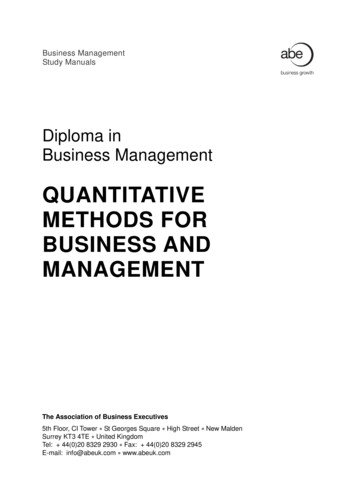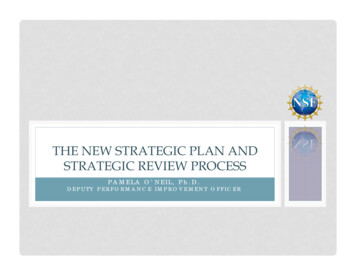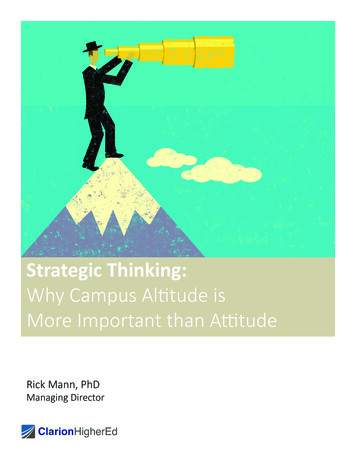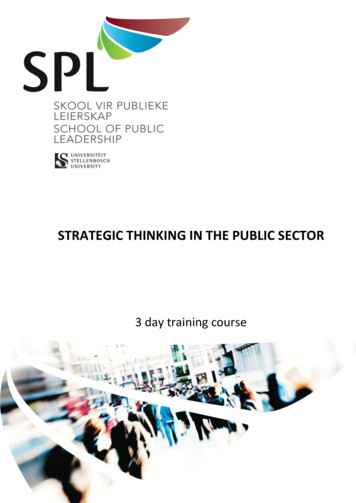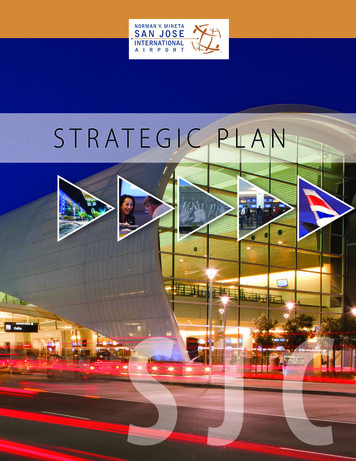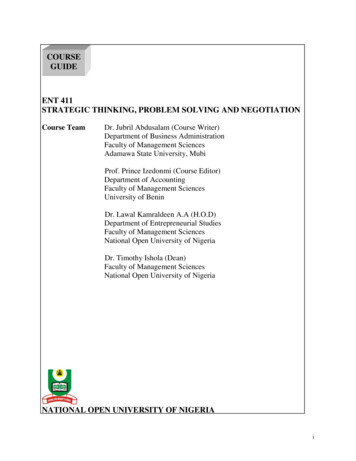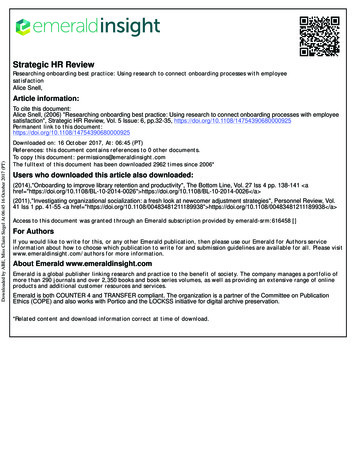
Transcription
Strategic HR ReviewResearching onboarding best practice: Using research to connect onboarding processes with employeesatisfactionAlice Snell,Article information:Downloaded by ABE, Miss Claire Siegel At 06:45 16 October 2017 (PT)To cite this document:Alice Snell, (2006) "Researching onboarding best practice: Using research to connect onboarding processes with employeesatisfaction", Strategic HR Review, Vol. 5 Issue: 6, pp.32-35, https://doi.org/10.1108/14754390680000925Permanent link to this Downloaded on: 16 October 2017, At: 06:45 (PT)References: this document contains references to 0 other documents.To copy this document: permissions@emeraldinsight.comThe fulltext of this document has been downloaded 2962 times since 2006*Users who downloaded this article also downloaded:(2014),"Onboarding to improve library retention and productivity", The Bottom Line, Vol. 27 Iss 4 pp. 138-141 ahref "https://doi.org/10.1108/BL-10-2014-0026" https://doi.org/10.1108/BL-10-2014-0026 /a (2011),"Investigating organizational socialization: a fresh look at newcomer adjustment strategies", Personnel Review, Vol.41 Iss 1 pp. 41-55 a href "https://doi.org/10.1108/00483481211189938" https://doi.org/10.1108/00483481211189938 /a Access to this document was granted through an Emerald subscription provided by emerald-srm:616458 []For AuthorsIf you would like to write for this, or any other Emerald publication, then please use our Emerald for Authors serviceinformation about how to choose which publication to write for and submission guidelines are available for all. Please visitwww.emeraldinsight.com/authors for more information.About Emerald www.emeraldinsight.comEmerald is a global publisher linking research and practice to the benefit of society. The company manages a portfolio ofmore than 290 journals and over 2,350 books and book series volumes, as well as providing an extensive range of onlineproducts and additional customer resources and services.Emerald is both COUNTER 4 and TRANSFER compliant. The organization is a partner of the Committee on PublicationEthics (COPE) and also works with Portico and the LOCKSS initiative for digital archive preservation.*Related content and download information correct at time of download.
Downloaded by ABE, Miss Claire Siegel At 06:45 16 October 2017 (PT)By Alice Snell, TaleoResearchingonboardingbest practiceUsing research to connect onboardingprocesses with employee satisfactionThe early stages of onboarding are crucial to establishinga lasting bond between employees and the company.Alice Snell, vice president of the research division oftalent management solution company, Taleo, outlines themethods organizations can use to maximize contributionand avoid the pitfalls of the onboarding process.32AS RECRUITMENT PROCESSES HAVEprogressed, the term onboarding has comeinto regular use in HR. However, arecompanies really adopting best practiceonboarding methods, or just the terminology?Increasing focus is being placed on the importance ofemployees within organizations and selecting the rightcandidate. However, for a company to truly benefitfrom the attributes and skills recognized in each newemployee, it’s essential to support them through acomprehensive introductory process.Getting the onboarding process rightOnboarding can be described as the direct bridgebetween the promise of new employee talent and theattainment of actual productivity. The onboardingprocess and experience, though, can vary widely.Onboarding a new hire can either be a well-managedand speedy path to employee contribution, or aninefficient and costly entry into the organization.Although onboarding appears to be purely atransactional activity, it can be a strategic process thatimproves your bottom line. How? Remember that newemployees start out as “liabilities” before they learnhow to use their skills and experience to make apositive contribution. The more quickly employees getup to speed, the sooner they can begin contributing toyour bottom line – regardless of their role ordepartment.Acting upon research findingsCompanies that don’t support a comprehensiveintroduction phase for new employees not only risklosing productivity generated by the employee but alsolosing their interest in the company. This is critical foremployees at all levels; 64 percent of new executiveshired from outside the company will fail at their newjobs1 and the average CEO is in the job for less thanfour years.2 These are worrying statistics and highlightthe importance of creating the right experience tooptimize productivity and retain employees.All new employees go through a learning curveduring which they perform below the level of a fullyproductive employee. Employee learning curvesrepresent the length of time required for employees innew positions to achieve full productivity, and the rateat which they progress towards full productivitythroughout the course of the ramp-up period. Figure 1,bottom right, shows the typical learning curve for anew employee.An effective onboarding process enables new teammembers to gain access to information, tools andmaterials needed to perform their function morequickly. Productivity generated by successfullyonboarding a new hire sooner will have a direct,positive effect on the overall productivity of thecompany.Volume 5 Issue 6 September/October 2006
Perhaps more difficult to quantify directly, additionalbenefits from optimized onboarding accrue in theseareas as well: Reduced time to contribution/competence. Improved employee productivity and performance. Stronger bonds among colleagues. Enhanced job satisfaction and loyalty. Improved employee engagement and retention. Enhanced employer brand.Figure 2. Sample of costs associated with onboarding a new hireFigure 1. A new employee’s typical learning curve“Improving onboarding processesreduces time to contribution andprevents the potential costsincurred by poor onboarding.”The business case for improved onboardingAlthough the ranges of savings vary based on thecurrent practices and implemented improvements,onboarding can yield a return on investment (ROI) inthe following financial terms: productivity gains,elimination of mailing-related costs, reduction of HRadministrative time processing forms, avoided re-keyingand better data integrity.Straightforward processes that support the basicrequirements of a new starter enable the employee toreach their full productivity in the shortest length oftime. They also ensure that talent isn’t lost due tocompany negligence. Improving the onboardingprocess reduces the time to contribution for a newemployee and prevents the potential costs incurred bypoor onboarding. See the estimated costs concerningeach new hire in Figure 2, top right.Perception versus realityMany companies are now aware of the benefits ofonboarding and aim to have such efficiencies in place.However, being aware of the processes and actuallyVolume 5 Issue 6 September/October 2006providing them is a different matter.From my experience researching the differentapproaches companies apply to onboarding, the perfectfirst day for a new hire would include paperworkhaving already been filled out, their workspace wouldbe set up and stocked with supplies, co-workers wouldwelcome their new team member, and a “buddy”would be assigned to the new employee to help themnavigate the new environment.In reality, this rarely happens. A 2005 Taleo researchsurvey of onboarding practices ofAlice Snelllarge corporations found mostrespondents reported an inconsistent is vice president ofTaleo Research. Sheand unsatisfactory approach topublished The Job-Seeker’s Guide to On3onboarding in their organizations : More than one third are without a Line Resources in 1994. Prior to joiningTaleo, Snell was a senior analyst at Kennedyformal process to monitor andInformation.coordinate completion oftDownloaded by ABE, Miss Claire Siegel At 06:45 16 October 2017 (PT)Analyzing streamlined onboarding processesProcess and technology improvements can deliver realbottom-line results derived from benefits including: Reduced time and effort for HR, hiring managersand others involved in onboarding. Improved speed and accuracy of data collection andtransfer between payroll and HRIS systems. Consistent legal and policy compliance. Reduced printing and shipping costs for onboardingforms. Ability to track new metrics for greater processefficiency. Better overall new hire experience including a single,self-service source of information during the crucialfirst days on the job. More effective employee/manager communication.33
tonboarding activities. The majority of survey respondents report a lack ofconsistency across their organization for onboarding. Variable onboarding practices apply as well to thestarting point for the onboarding process. Less than half of respondents are satisfied with theonboarding process at their company.These results show that many companies still have along way to go to implement processes that areconsistent across the organization.Downloaded by ABE, Miss Claire Siegel At 06:45 16 October 2017 (PT)Global considerationsFor global companies, onboarding has even moreimplications. Higher recruitment rates, multiple levelsof corporate policy and culture to impart andmultilingual/multicultural barriers are all aspects whichmake the success of the process even more critical. Forlarge corporations it’s imperative not to lose this timeand to manage the system efficiently.Aligning onboarding with other processesOnboarding is just one piece of the cyclical continuumin the management of talent (see Figure 3, right); it’snot merely a standalone or linear activity. Done well,and integrated into an organization’s talentmanagement systems, onboarding presents an easybusiness process improvement that can yield greatreturns.The keys to successful onboarding are a completeand consistent process, a technology platform with aconfigurable workflow and a seamless integration withyour organization’s talent management system. Similarto any process improvement, establishing a bestpractice and technology-supported onboarding processrequires upfront work to determine the tasks required.On top of this, it’s also necessary to find the balancebetween organizational consistency and flexibility toaddress department-level needs.Four steps to an effective onboarding processOnce processes and business logic have beenestablished, automation can be effectively applied. Thetechnology typically handles data-gathering from thenew hire and from within the organization, internaland external communications such as service requestsand reminders, data transfer to the HR informationsystem (HRIS) and sometimes orientation andtraining.!TALEOTaleo Research analyzes the best practices and economics of talentmanagement. Taleo Research is the research division of Taleo. Leadingorganizations worldwide use Taleo on demand talent management solutionsto assess, acquire, develop and align their workforce for improved businessperformance. Taleo has 550 employees worldwide.34Four components are critical for the design andmanagement of a successful onboarding process:1. Process analysis.2. Implementation.3. Integration.4. Reporting.1. Process analysisProcess analysis includes a review of the onboardingprocess and role impact. Many stakeholders areinvolved in the onboarding process. The primaryparticipants are the new hire, the hiring manager andthe HR department. Traditionally, onboardingactivities of a new hire involve: Payroll and benefits. Forms and enrollment; initiatepayroll and establish direct deposit/deductions. Buildings and grounds. Parking permit and parkingspace designation. Office manager. Assign and set up workspace,distribute supplies needed to perform work. Security department. Process and provide badges orother documentation for access to building andadditional secure areas as appropriate. Training. Sign-up and delivery of job-specifictraining. Team members/mentors. General orientation, tourof offices and facilities, introduction to otheremployees. IT department. If applicable, allotment of computerhardware and software, pagers, PDAs, telephone andtelephone number.The flow of the onboarding process is demonstrated byFigure 4, right.42. ImplementationThe implementation phase includes configuration ofthe onboarding technology with, for example, a newhire and administration portal, workflow,correspondence management and custom forms.3. IntegrationThis component involves the integration of new hireinformation and external systems.4. ReportingThe reporting component should be designed to pushkey metrics and analytics for monitoring the processand driving continuous improvement.Automating HR practicesOnboarding technology platforms cannot perform thesocialization activities that are so integral to successfulonboarding. However, the technology platform canmove onboarding from a haphazard paper and pencilchecklist to a systematic workflow which drives theprocess. In the best systems, automated correspondenceVolume 5 Issue 6 September/October 2006
Downloaded by ABE, Miss Claire Siegel At 06:45 16 October 2017 (PT)to candidates and internal personnel can be embeddedin workflows. Data entry can be accomplished justonce and then flow to the many forms and systemsnecessary. Reduced data re-entry decreases the timespent by the organization on administrative tasks andalso provides a better experience for the new hire,promoting positive employee engagement.At one UK company, new hires were known to havewaited one or two weeks before their phone, computerequipment, or workspace was in place because of theinability to gather date of birth and other personalinformation prior to date of hire. This process needs tobe facilitated before the new hire starts, taking intoaccount concerns about gathering the data during therecruitment process. In this instance, a process wascreated to capture this information after the applicantaccepts a verbal offer, but prior to their start date. Theresults of the company’s improved onboarding processinclude: Number of paper forms has been reduced from fourto one (other than the forms required by the UKgovernment). More immediate and accurate data is fed to payroll. New hires have required equipment (phone, PC,workspace) on day one.Figure 3. Onboarding’s role in the talent management cycle (Source: Taleo Research)Figure 4. An onboarding process timeline example (Source: Taleo Research)Onboarding processes that are part of a talentmanagement system enable companies to takeadvantage of data collected during the recruitmentprocedure and ensure that the onboarding process isinitiated prior to the employee start date. Integratedonboarding solutions provide the ability to trackactivities and push appropriate requests, reminders anddata which greatly hastens the overall inductionprocess and shortens ramp-up time. At Taleo, we’vevalidated reductions in time to onboarding in rangesfrom 10 percent to 80 percent.The onboarding advantageOptimized onboarding presents clear and significantbenefits. A well-designed and automated onboardingprocess reduces costs, hastens time to productivity andimproves retention due to greater employeesatisfaction. As an element of an organization’s talentmanagement strategy, streamlined onboarding alsoincreases efficiency, reduces process variances, providesbetter service levels for hiring managers and createsmore staffing-process consistency.Today, organizations strive to identify businessprocess improvements that generate real results.Optimizing your onboarding process in conjunctionwith your talent management solution is an obviouschoice for an expedient, cost-effective project thatdelivers on every requirement.Volume 5 Issue 6 September/October 2006,CONTACTAlice SnellE-mail: asnell@taleo.comReferences:1. Right from the Start by Ciampa, D and Watkins, M (Harvard Business School Press, 1999).2. Rich Rosen, The Economist 13 July 20063. Taleo Research Onboarding Survey, March 2005, completed by 46 large organizations.4. Taleo Research Onboarding: Speeding the Way to Productivity, 2006. www.taleo.com35
Downloaded by ABE, Miss Claire Siegel At 06:45 16 October 2017 (PT)This article has been cited by:1. DeBodeJason D., Jason D. DeBode, MossholderKevin W., Kevin W. Mossholder, WalkerAlan G., Alan G. Walker. 2017.Fulfilling employees’ psychological contracts: organizational socialization’s role. Leadership & Organization DevelopmentJournal 38:1, 42-55. [Abstract] [Full Text] [PDF]2. Afif N. Kulaylat, Danni Qin, Susie X. Sun, Christopher S. Hollenbeak, Jane R. Schubart, Antone J. Aboud, Donald J.Flemming, Edward R. Bollard, Peter W. Dillon, David C. Han. 2017. Aligning perceptions of mistreatment among incomingmedical trainees. Journal of Surgical Research 208, 151-157. [Crossref]3. Glenn E. Littlepage, Michael B. Hein, Richard G. Moffett, Paul A. Craig, Andrea M. Georgiou. 2016. Team Training forDynamic Cross-Functional Teams in Aviation. Human Factors: The Journal of the Human Factors and Ergonomics Society58:8, 1275-1288. [Crossref]4. Chad A. Proell, Stephen Sauer, Matthew S. Rodgers. 2016. Credit Where Credit is Due: A Field Survey of the InteractiveEffects of Credit Expectations and Leaders’ Credit Allocation on Employee Turnover. Human Resource Management 55:2,341-355. [Crossref]5. Kenrick Hendricks, Joha Louw-Potgieter. 2012. A theory evaluation of an induction programme. SA Journal of HumanResource Management 10:3. . [Crossref]6. Guangrong Dai, Kenneth P De Meuse, Dee Gaeddert. 2011. Onboarding externally hired executives: Avoiding derailment –accelerating contribution. Journal of Management & Organization 17:2, 165-178. [Crossref]7. Maggie Johnson, Max Senges. 2010. Learning to be a programmer in a complex organization. Journal of Workplace Learning22:3, 180-194. [Abstract] [Full Text] [PDF]8. Krishna Lynch, Gia Buckner-Hayden. 2010. Reducing the new employee learning curve to improve productivity. Journal ofHealthcare Risk Management 29:3, 22-28. [Crossref]
TALEO Taleo Research analyzes the best practices and economics of talent management.Taleo Research is the research division of Taleo. Leading organizations worldwide use Taleo on demand talent management solutions to assess, acquire, develop and align their workforce for improved business
